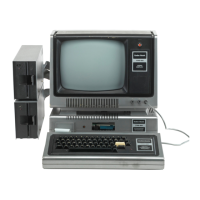
Do you have a question about the Radio Shack TRS-80 DT-1 and is the answer not in the manual?
| Model | TRS-80 DT-1 |
|---|---|
| Category | Desktop |
| Manufacturer | Radio Shack |
| CPU | Zilog Z80 |
| CPU Speed | 1.77 MHz |
| RAM | 64 KB |
| Operating System | TRS-DOS |
| Display | Monochrome |
| Storage | Cassette tape |
Explains the fundamental concept of a data terminal and its role in computer communication.
Describes where the host computer can be situated relative to the DT-1 terminal.
Outlines the DT-1's ability to communicate with other DT-1s and lists its key features.
Provides an overview of the DT-1 keyboard layout, including the main typing area.
Explains the DT-1 keypad layout, cursor movement keys, and special function keys.
Identifies and describes the physical ports and controls on the DT-1 terminal.
Guides the user on how to establish a connection between the DT-1 and a TRS-80 computer system.
Explains the necessary RS-232 interface configuration and lists available Radio Shack cables for connection.
Details the specific pin assignments for the RS-232-C interface used by the DT-1 and TRS-80.
Provides instructions for connecting the DT-1 to TRS-80 Model II and Model 16 computers.
Provides instructions for connecting the DT-1 to TRS-80 Model III computers.
Provides instructions for connecting the DT-1 to TRS-80 Model I computers.
Guides on establishing a connection to a modem for telephone line communication.
Explains how to connect both parallel and serial printers to the DT-1 terminal.
Details the procedure for turning the DT-1 terminal on and off using the power switch.
Describes the initial screen display and how to adjust video brightness and contrast.
Introduces the concept of I/O parameters and the DT-1's software-selectable switches for configuration.
Explains how to set terminating characters for commands based on Host requirements.
Describes how to set the DT-1 to emulate different terminal types like Televideo 910.
Details how to configure reverse video (black on white) or normal video (white on black) display.
Explains the DTR signal's role in indicating terminal readiness for communication.
Describes the DSR signal and how the DT-1 responds to Host readiness for data.
Explains the DCD signal, typically from a modem, for enabling communication.
Guides on selecting one or two stop bits for data transmission.
Details how to set parity for error checking and select odd or even parity.
Explains how to set the word length to 7 or 8 bits for data transmission.
Provides a table and method for selecting various baud rates for communication.
Configures whether a line feed is sent with a carriage return upon pressing ENTER.
Controls whether the cursor automatically moves to the next line at the end of a screen line.
Sets the terminal for full-duplex (Host echo) or half-duplex (local echo) operation.
Allows selection of different cursor types like blinking block or underline.
Shows an example of the I/O parameter menu display with settings.
Explains how to save configured I/O parameters permanently in the terminal's memory.
Details how to store I/O parameters temporarily for the current session only.
Describes the two printer interfaces (serial and parallel) available on the DT-1.
Explains how data is handled by printers, including baud rate synchronization and BUSY signals.
Details how the DT-1 handles printer BUSY signals and uses CONTROL S/Q for flow control.
Introduces Local Mode for executing commands without Host intervention.
Explains how to use escape code sequences for local mode operations.
Details how to use control code sequences for local mode operations.
Describes special functions like reverse video and software restart using specific key combinations.
Guides on activating and interpreting the DT-1's built-in self-test feature.
Provides initial steps for diagnosing and resolving issues with the DT-1 or system.
Offers general advice and tips for ensuring proper system configuration and operation.
Lists key physical and electrical specifications of the DT-1 terminal.
Provides the pinout details for the RS-232-C interface as described in Table 3.
Details the pin assignments and functions for the parallel printer interface (Table 4).
Provides ASCII character set and keyboard code mappings for the DT-1.
Lists keyboard command equivalents for emulating common terminals like Televideo, ADDS, ADM-5, and Hazeltine.
Defines terms, explains cursor coordinates, and lists control codes for video display.











